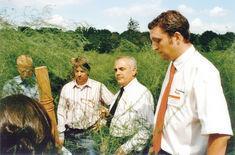
The evidence is already there, and was illustrated by trials at the company’s open day last week at West Bilney, near Kings Lynn. Some 183 varieties, representing the largest trial site in the world, according to Hargreaves, are in the first stages of being evaluated for shape, yield, and the ways they could extend the shoulders of the existing two-month UK gras season.
Jamie Petchell, Hargreaves’ asparagus project leader, told the audience that first-year results were “a world away” from Dutch-sourced varieties Backlim and Gijnlim, which represent the bedrock of the industry. “They tasted of asparagus, but they were bland next to others,” Petchell says.
Next year, there will be more data on which to build, and technologist Marie-Laure Martin revealed that research will go further by assessing brix levels and the volume of marketable first-class crop, as well as its longevity after harvesting.
By then, a third of the varieties, which have failed to make the grade, will have been discarded after feedback has been provided to the nine breeders involved in the trial.
New asparagus strains will be included in 2008.
Despite it still being a little early to confidently predict the winners, Hargreaves selected four for the open day, which it believes show particular promise. They were Canadian Guelph Millennium, US Jersey Giant, Dutch Ariane, Italian Ercole, and New Zealand Pacific 2000.
“Many under trial have been shown to have better head quality, higher yield - either later or earlier - and have often been sweeter,” says Petchell. Pacific 2000, he adds, has been the most impressive to date.
The alternatives, though, are almost limitless, if the Italian experience is anything to go by. Dr Agostino Falavigna of the CRA research Institute for Vegetable Crops at Montanaso Lombardo, the only European programme supported by government, has a potential 42,000 crosses from local traditional varieties grown by an industry which despite its fragmented nature produces 43,274 tonnes a year.
The season, which starts in the south and snakes northwards to an end in the Italian Alps, is one of the world’s longest, running from February until June. While the majority is green, there are plenty of white lines, and even pink asparagus is still grown in the north west.
Falavigna began the breeding programme in 1974 and it is now responsible for 70 per cent of Italian production. This has already allowed crowns to be produced that adapt to the country’s various climatic and soil bands, and varieties developed to be drought-resistant or suitable for production in coastal areas where the land’s salt content is high.
Meanwhile, Petchell says, changes will take place in the UK within a market that continues to expand and remains equally balanced at present between production and consumption. “New varieties will continue to be taken up as growers demand better marketable yields and customers look for points of difference,” he says. “There will also be a need for larger plants with higher densities, to reduce pay-back time and lower labour costs.”
But while the industry is buoyant, the audience heard a word of warning about next years’ crop which is now in the fern stage after harvesting. Professor Dan Drost of the University of Utah, says it is during this period that crowns build up carbohydrate levels as their “fuel tank”, dictating the scale of the 2007 yield.
Based on this summer’s weather patterns in the UK, Drost adds: “I can foresee the damage has already been done, because the bud size is small.”
Drost is an international figure whose work covers plant physiology and growth, particularly root structures. He is an advisor to the California, Washington, New Zealand and Peruvian gras industries.



